Brand safety has aways been a concern for marketers, but in the wake of never-ending political and social debates, Google is fighting an uphill battle for trust. While YouTube is celebrated for its diversity in discussion and opinions, brands are demanding more control on what kind of messages their ads appear next to. Google is taking steps to reassure its advertisers across YouTube and the Google Display Network, but is that enough?
The world’s most popular video-sharing site came under fire earlier this year when it was discovered that ads were running next to extremist content. Ads were pulled, funds were diverted to other platforms like traditional TV and YouTube creators have suffered considerable drops in income.
“You’ve told us to do better when it comes to ad placement,” YouTube CEO Susan Mojcicki told the audience at Newfronts. “I want you to know that we have taken your feedback to heart. We work hard every day to earn our advertisers’ and agencies’ trust, and we apologize for letting some of you down. I’m here to say that we can and will do better.”
Taking Control
Speaking at a YouTube press breakfast at Cannes Lions on Tuesday, Matt Brittin, Google’s president of EMEA business operations, said that YouTube is “using the latest technology” to fight terrorist and extremist content.
“We’re using machine learning in the fight against this,” he said. “If someone uploads a video that we identify as unacceptable, we can fingerprint it . . . to stop them from being reposted.”
In other words, video content that YouTube’s algorithm or third-party deems “inappropriate” could be black-listed across not only YouTube, but “industry colleagues” like Facebook and Twitter.
Now comes the hard part—differentiating strong opinions from downright hate speech or terrorist sympathizers.
“In many cases,” Brittin said, “it’s a man talking to a camera about politics. [Inappropriate content] is quite hard to identify—it’s a nuanced decision in some cases.”
Determining which opinions are appropriate is much easier said than done, and opens the practice up to even more endless debate on the issues of freedom of expression. That being said, Google isn’t tackling this monumental task alone.
In April, Google unveiled plans to use comScore as a third-party measurement company to monitor where ads appear on YouTube. Marketers would receive “brand safety” reports to include a full list of specific videos next to which ads were shown, according to statements made to The Wall Street Journal.
Brittin admitted that previous ad controls were “too complicated,” and that YouTube is working with brands to ensure they know how to use them.
Guilty By Association
Now more than ever, socially conscious and digitally connected consumers want to know that their favorite brands share similar views—but taking a stand is far from risk-free.
A consumer study fielded by SSRS found that 58 percent dislike when brands get political and are more likely to avoid brands that take a position contrary to their beliefs. A separate study from the CMO Council found that 37 percent change how they think about a brand when an ad appears next to objectionable content. In addition, 10 percent said they would boycott the brand, and nine percent said they would be vocal or complain.
Regardless of its public controversies, ad spend on YouTube has remained fairly stable, according to ad-tracking firms Pathmatics and MediaRadar. In fact, MediaRadar found ads from six US brands boycotting YouTube appearing within the last month.
Google will weather this storm one way or another. Programmatic ad spend in the US will total $32.56 billion this year, according to forecasts by eMarketer. By 2018, nearly three quarters of all video ad dollars will transact programmatically.
Fake news and failed attempts at social justice advertising don’t help matters either, which makes it just one of the many reasons building marketing strategies is becoming more complicated than ever.

